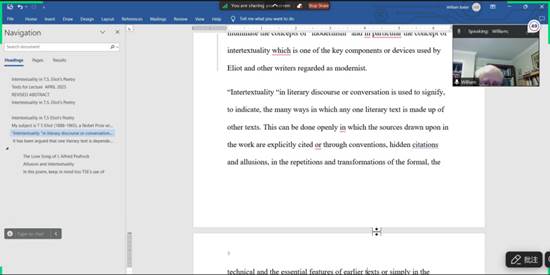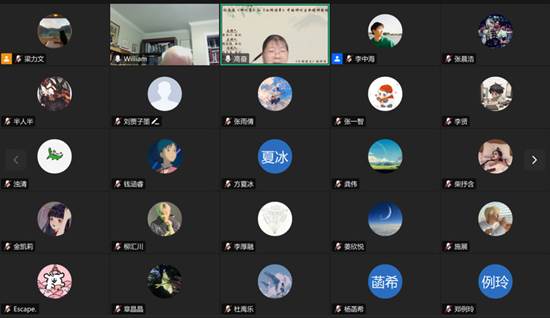On the morning of April 20, Professor William Baker was invited to deliver a webinar titled “T. S. Eliot and Intertextuality.” Professor Baker, a distinguished scholar from Northern Illinois University and International Advisor to Zhejiang University’s Center for Medieval and Renaissance Studies (CMRS), has authored over 30 scholarly monographs and published more than 180 academic papers. The lecture, hosted by Zhejiang University’s Institute of Foreign Literature and Center for Modernist Studies, was chaired by Professor Gao Fen, Director of the Institute of Foreign Literature. Over fifty faculty members and students from various domestic universities and research institutions were present at the webinar.

The lecture began with Professor Baker’s overview of T. S. Eliot’s life and literary career, introducing the core concept of “intertextuality” and its profound connection to modernist literary movements. He noted that the term was first established by French semiotician Julia Kristeva in her “Word, Dialogue, and the Novel,” a paper published in 1966, emphasizing that texts are never isolated but achieve “multiplication of meaning” through absoring, transforming and reconstructing existing texts. Professor Baker then conducted incisive analyses of intertextual elements in multiple Eliot poems. In “The Love Song of J. Alfred Prufrock,” he identified intertextual links with the Bible, Dante’s Divine Comedy, Andrew Marvell’s “To His Coy Mistress,” and Shakespeare’s “Hamlet”. The poem’s formal hybridity, blending free verse with mixed-meter structures, was highlighted as mirroring the protagonist’s psychological complexity. Turning to “The Waste Land,” he examined its epigraph from Petronius’s first century “Satyricon,” the dedication to Ezra Pound inspired by Dante’s “Purgatorio,” and the iconic opening line, “April is the cruelest month,” which subverts the celebratory tone of the Chaucer’s “The Canterbury Tales” (“Whan that Aprill with his shoures soote”). Professor Baker also analyzed the unconventional rhythms in Old Possum’s Book of Practical Cats, particularly of “Macavity: The Mystery Cat,” arguing that its experimental prosody aligns with modernist formal innovations. His engaging presentation, enriched with visual materials and witty commentary, received enthusiastic responses from the audience.
During the Q&A session, participants raised questions about poetic interpretation, methodologies for intertextual studies, and Eliot’s intentionality in employing intertextuality. Professor Baker addressed these inquiries in depth, fostering vibrant academic exchanges. In her concluding remarks, Professor Gao Fen emphasized that the lecture’s multidimensional analysis not only deepened understanding of Eliot’s modernist practice but also exemplified rigorous intertextual scholarship. The event concluded amidst warm applause.

Institute of Foreign Literature and Center for Modernist Studies, ZJU
Translated by SUN Fangrui, Proofread by XU Xueying



